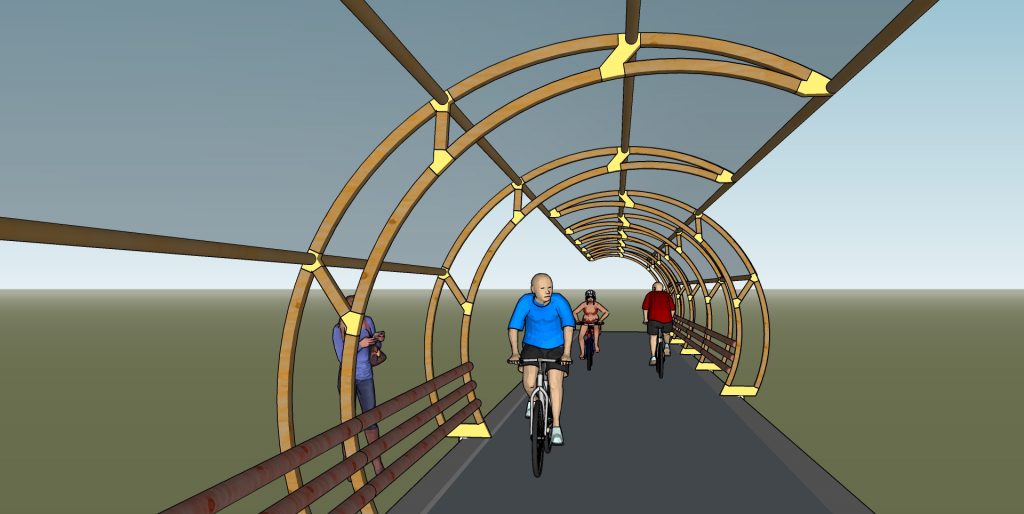Sheltering bike paths increases quality of urban life

Traffic jams, no parking spaces and bad air quality are some of the issues urban life is facing today. Alternative means of transportation become more and more attractive.
The infrastructure for cyclists, skater, e-biker, and others in our cities is constantly improving – leaving one central problem unaddressed: Weather. Conditions like rain and snow mean lack of safety and comfort for cyclists and others.
The solution?

Sheltering bike paths from weather conditions makes cycling safer, faster and more enjoyable. No need for winter service!
By offering sheltered bike paths, cities would address the above mentioned issues: Less car traffic, better air quality, more space.

Guardrails increase safety by guiding routes and preventing crossing traffic. Rounded wood lowers the risk of injury on crash significantly, compared to guidance systems made from steel.
Street lighting and informations systems can easily be integrated.
Sheltering bike paths will create a whole new experience of urban mobility, increasing quality of life in cities.

Minimum of CO2 saving: 60t / km
Yes, that are 60 metric tons of saved CO2 per kilometer. Or about 82026 lbs per mile. Wooden structures are not only a lot more energy efficient to produce, but also contain CO2 as a natural storage. Compared to a similar structure made from steel, the potential of this wooden structure saving preventing CO2 sums up to about 120 metric tons per km.
Some more specifications:
- Main source for construction material is locally sourced timber from forestry for carrier, purlins and guardrail.
- The design form follows a geometric circle.
- As a tubular segment this structure has very high stiffness, enabling the roof material to be very thin and non-load-bearing.
- The high degree of preproduction speeds up the assembly process.
- Wood as a construction material is both lightweight and highly stable, while remaining flexible. This leads to collective load-bearing behavior within the structure.
- Because whole framework is planned and produced using the Bambutec system, weather-resistance, stability and longevity is proven in several applications. Of course snow- and wind-load are accounted for.
- Left- and right-hand assembly is possible, offering high flexibility in terms of accessibility and connecting routes.

Helical piling – a foundation method with exceptional properties
The carrying capacity of one helical-pile is depending on soil conditions, size of the helix, their quantity and the depth of insertion.
These dependencies can be adapted to the individual requirements on site. During the insertion of a helical-pile, the applied torque is in direct proportion to the actual load-bearing capacity, meaning that this capacity is exactly adjustable and controllable. That is a significant advantage because at every position, soil conditions differ.
Helical-piles consist of a sharpened steel pipe to which a helical formend wing is welded. Then the pile is “screwed” into the ground, just like a screw. That process happens without any movements or disturbance in the soil and is reversible. Just like it is screwed in, it can be unscrewed and reused at any time.
For the application on the concept of bike-path-sheltering rigid clamping of the structure is required. Helical-piles meet this requirement particularly well.

Let’s talk dimensions
Of course, like any Bambutec structure, this concept is highly scalable and therefore these are only exemplary values. This concept however is realizable as presented, meeting every structural and safety-related requirements. Depending on expected snow- and wind-load, the components’ diameter is to be adjusted.
- All wooden components are oil impregnated and therefore protected against moisture and parasites.
- The fire protection class can be increased by special, also eco-friendly treatment.
- Guidance rails are made from half-round milled wood.
- Exemplary width: about 3.1 meters
- Exemplary height: about 3 meters
- Exemplary roofing material: 2mm polycarbonat
- Maximum distance between lazier segments in this design: 4 meters
Cost influencing factors
- type of material used for roofing
- required distance between lazier
- base-width of the way itself
- soil condition
- expected wind- and snow-load
- desired type of wood (spruce, pine, oak, larch, douglas fir, etc.)
As orientation value, the presented concept can be expected to be priced as low as 300€ per meter for a minimum of 10km total.
Considering the amount cities currently invest into urban infrastructure, this concept offers a solution to many existing problems, being absolutely reasonably priced. Planning eco-friendly does not need to be expensive!






